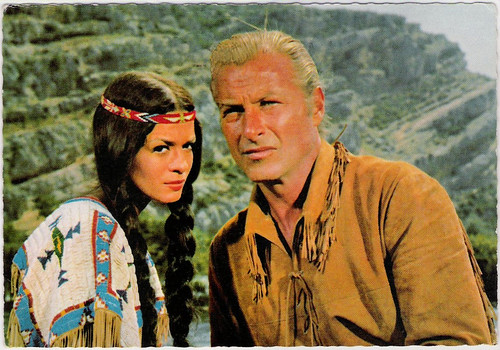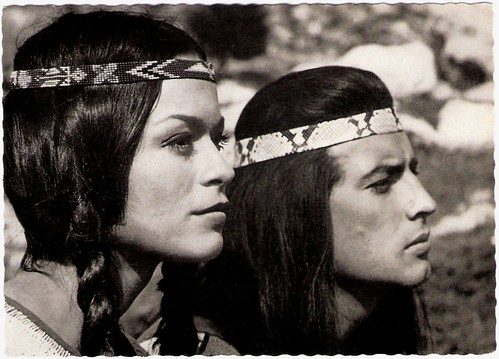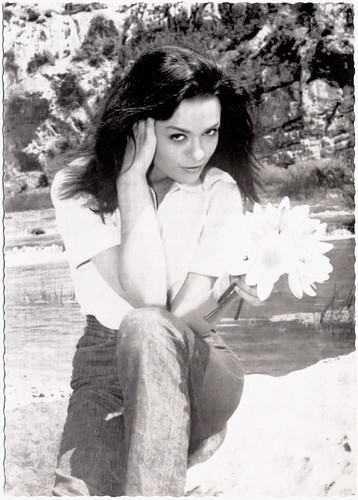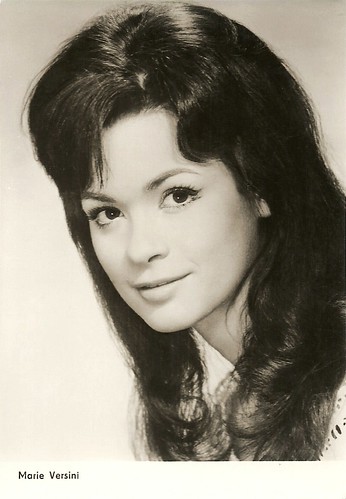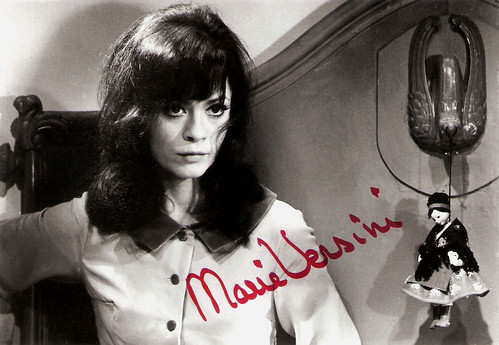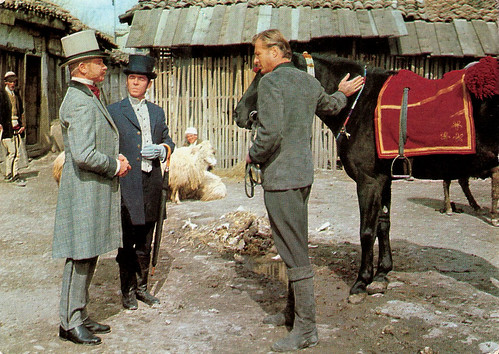
German postcard by Heinerle Karl-May-Postkarten, no. 2. Photo: CCC / Gloria. Dieter Borsche, Chris Howland and Lex Barker in Der Schut/The Yellow One (Robert Siodmak, 1964). Caption: "Mister Kara, so good that I meet you. Your friend Galingré was attacked and kidnapped by bandits of the Yellow One. A certain Nirwan visited me on board of my yacht and told me about it .'- 'In these circumstances, I can not travel with you to Egypt of course, Sir David, which will you understand. I will ride to Strumnitza where my kidnapped friend's wife lives ... I need to find the Yellow One'!"
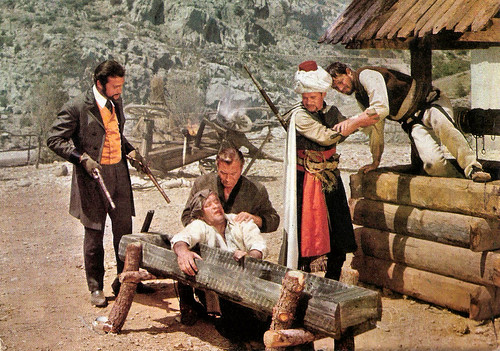
German postcard by Heinerle Karl-May-Postkarten, no. 7. Photo: CCC / Gloria. Publicity still for Der Schut/The Yellow One (Robert Siodmak, 1964). Caption: "Do not worry, my good man. We are friends of yours. My Sidi, the famous Kara Ben Nemsi, and I will do everything possible to catch these rogues, the Schut."
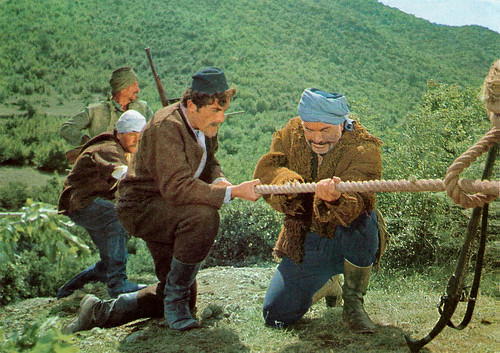
German postcard by Heinerle Karl-May-Postkarten, no. 9. Photo: CCC / Gloria. Renato Baldini in Der Schut/The Yellow One (Robert Siodmak, 1964). Caption: "'Barud, take my knife! '- 'Yes, now it gets better! If someone should like to persecute us, then he just needs to come across the bridge."

German postcard by Heinerle Karl-May-Postkarten, no. 13. Photo: CCC / Gloria. Friedrich von Ledebur in Der Schut/The Yellow One (Robert Siodmak, 1964). Caption: "I am so afraid of the Holy Mübarek, he will be angry that I speak to you, and his ravens will tell him what I told you ... That he warned the people for you ...!"
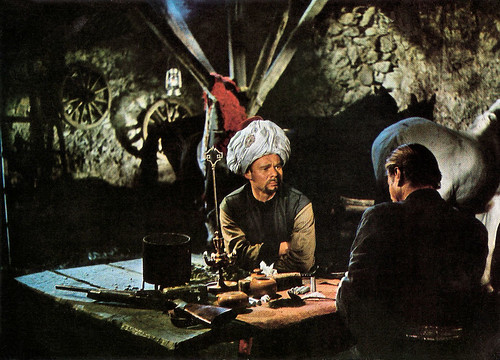
German postcard by Heinerle Karl-May-Postkarten, no. 15. Photo: CCC / Gloria. Ralf Wolter and Lex Barker in Der Schut/The Yellow One (Robert Siodmak, 1964). Caption: "In the evening at home Galingré: 'Halef, I will play a trick on the Mübarek. Therefore, you had to get me bismuth and mercury. From this, I'll make bullets that look like lead bullets but disintegrate during firing. Now I'll load the gun alternately with a bullet made of lead and a fake one ...'"

German postcard by Heinerle Karl-May-Postkarten, no. 16. Photo: CCC / Gloria. Lex Barker, Ralf Wolter and Friedrich von Ledebur in Der Schut/The Yellow One (Robert Siodmak, 1964). Caption: "The Holy Mübarek faces his opponent, Kara Ben Nemsi. "This blonde Giaur will be punished because he shot a sacred raven. It is the will of Allah!" - You lie, Mübarek. It is not God's will but yours. You're afraid of me because I am a greater magician than you. I want to prove it to you. Here is a gun that shoots more accurately and better than any other. If you can meet with a single bullet, then it should belong to you, Mübarek. Halef, show him the rifle and how to fire it."
Heroic Kara Ben Nemsi
The secretive 'Schut' or 'The Yellow One' (Rik Battaglia) is a bandit king who terrorises a whole region in the land of the Skipetars - modern Albanians, one of the few Balkan people who adopted the Turkish Muslim faith. He controls the land in the disguise of the wealthy Persian carpet merchant Nirwan.
The Schut holds an English aristocrat and a French merchant for a ransom, then he also abducts the beautiful Tschita (Marie Versini), Kara's friend Omar's fiancée. The corrupt police force does not take any action against him.
Heroic Kara Ben Nemsi, the Turkish-Arabic name means 'black(bearded) German' (Lex Barker) tries to find the Schut's hiding-place in the mountains and free the prisoners. But the Schut has many rogues and assassins under his command who make this search long and dangerous.
After unmasking the Mübarek, a local phony 'magician', and dealing with some other ruffians and corruption, Kara Ben Nemsi and Lord Lindsay (Dieter Borsche) with his butler Archie (Chris Howland) set out to finish The Schut off.
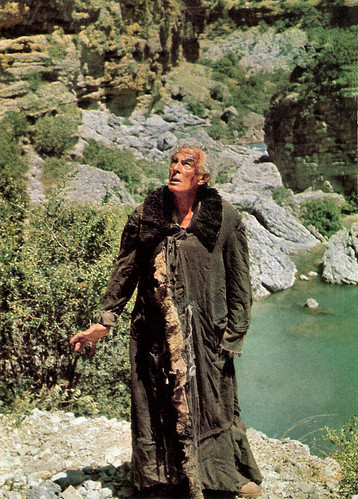
German postcard by Heinerle Karl-May-Postkarten, no. 17. Photo: CCC / Gloria. Friedrich von Ledebur in Der Schut/The Yellow One (Robert Siodmak, 1964). Caption: "Do you see what's behind the mask of this saint? Halif has torn down his coat and forth came the tattered dress of the supposedly lame and deaf-mute beggar Busra. He was always everywhere and nowhere - despite his ill legs. Not the Ravens have told the Mübarek everything, but he could hear himself what was being said about him."

West-German postcard by Heinerle Karl-May-Postkarten, no. 20. Photo: CCC / Gloria-Verleih. Marie Versini in Der Schut/The Yellow One (Robert Siodmak, 1964). Caption: "Let go of me! If you don't want to help me, then at least let me ride away. Let me go, I want to leave!"
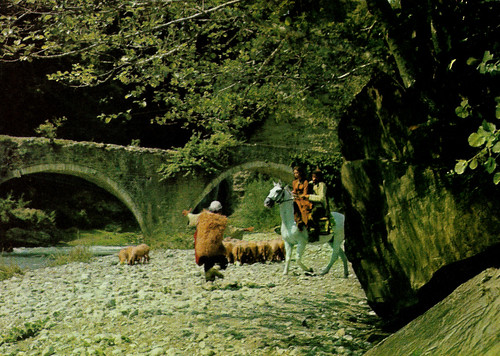
West-German postcard by Heinerle Karl-May-Postkarten, no. 22. Photo: CCC / Gloria-Verleih. Marie Versini in Der Schut/The Yellow One (Robert Siodmak, 1964). Caption: Manach returned to the hostel and dragged Chita on. "Hello, shepherd! I've got a pretty little bird that Schut has been waiting for. I'll take her to a cave now. In the meantime, hold my horse!"

West-German postcard by Heinerle Karl-May-Postkarten, no. 24. Photo: CCC / Gloria-Verleih. Marie Versini in Der Schut/The Yellow One (Robert Siodmak, 1964). Caption: "You have a visitor, gentlemen! Here sit all those who have disobeyed the Schut. That one, in the grey suit, is Monsieur Galingré, a man with a lot of money, haha!"
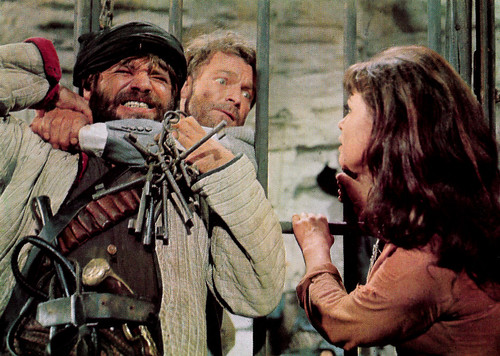
West-German postcard by Heinerle Karl-May-Postkarten, no. 25. Photo: CCC / Gloria-Verleih. Pierre Fromont and Marie Versini in Der Schut/The Yellow One (Robert Siodmak, 1964). Caption: "Monsieur Galingré - for God's sake what are you doing!" - "Don't mind me! Get out of here as fast as you can, or you'll be lost!" - "You'll pay for this, Frenchman, you scoundrel!"

West-German postcard by Heinerle Karl-May-Postkarten, no. 26. Photo: CCC / Gloria-Verleih. Marie Versini in Der Schut/The Yellow One (Robert Siodmak, 1964). Caption: Chita, who escaped from prison as silently as a wildcat, is fighting for life and limb. Her unsuspecting guard is already a dead man.
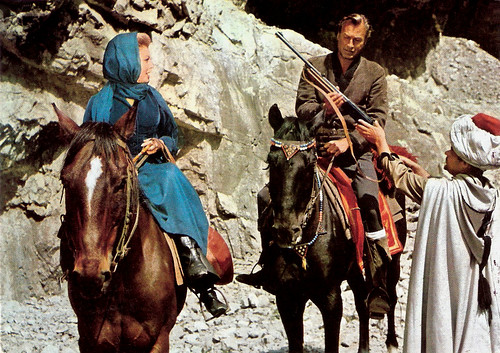
German postcard by Heinerle Karl-May-Postkarten, no. 29. Photo: CCC / Gloria. Marianne Hold and Lex Barker in Der Schut/The Yellow One (Robert Siodmak, 1964). Caption: "How glad I am that nothing happened to you, Mister Kara (Lex Barker). I heard the shots ...." - 'As you can see, everything went well with this Mübarek, Madame Galingré (Marianne Hold). Fine that you brought the horses. Omar, Halef, and I can immediately do on with the persecution of The Yellow One'."
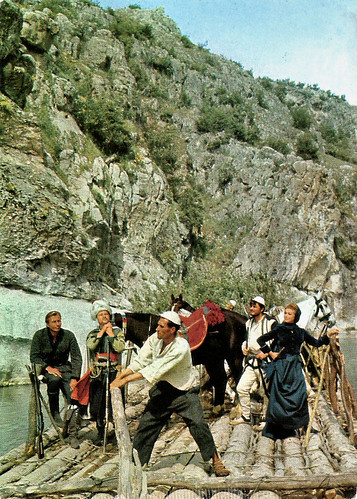
German postcard by Heinerle Karl-May-Postkarten, no. 31. Photo: CCC / Gloria. Lex Barker, Ralf Wolter and Marianne Hold in Der Schut/The Yellow One (Robert Siodmak, 1964). Caption: "The fully loaded raft. A good target for the bandits, who are hiding between the rocks."

German postcard by Heinerle Karl-May-Postkarten, no. 36. Photo: CCC / Gloria. Dusan Janicijevic in Der Schut/The Yellow One (Robert Siodmak, 1964). Caption: "For the last time! Where is my bride Tschita? Where did you drag her?"

German postcard by Heinerle Karl-May-Postkarten, no. 37. Photo: CCC / Gloria. Lex Barker and Marianne Hold Der Schut/The Yellow One (Robert Siodmak, 1964). Caption: "A short break is inserted, so Madame Galingré can recover from the rigors of the raid. The next morning the search for the Yellow One will be continued."

German postcard by Heinerle Karl-May-Postkarten, no. 39. Photo: CCC / Gloria. Ralf Wolter in Der Schut/The Yellow One (Robert Siodmak, 1964). Caption: "They have pulled Halef into the canyon lodge and tied him up there. 'Where is Kara holding on? Speak... or! '- But Halef remains silent and resists all threats and beatings."
Karl May's Oriental Cycle
Der Schut was not the first adaptation of the Oriental novels with Kara Ben Nemsi by Karl May. In 1920, May's friends Marie Luise Droop and her husband Adolf Droop among others founded in cooperation with the Karl May Press the production company Ustad-Film.
They produced three silent films: Auf den Trümmern des Paradieses/On the Brink of Paradise (Josef Stein, 1920), Die Todeskarawane/Caravan of Death (Josef Stein, 1920) and Die Teufelsanbeter/The Devil Worshippers (Marie Luise Droop, 1920), all starring Carl de Vogt as Kara Ben Nemsi. These three films are believed to be lost. Due to the low success, Ustad-Film went bankrupt in the following year.
The first sound film was Durch die Wüste/Through the Desert (J.A. Hübler-Kahla, 1936). Kara Ben Nemsi was played by Fred Raupach.
The German-Spanish Die Sklavenkarawane/Caravan of Slaves (Georg Marischka, Ramón Torrado, 1958) and its sequel Der Löwe von Babylon/The Lion of Babylon (Johannes Kai, Ramón Torrado, 1959) were the first colour films. In the first film, Kara Ben Nemsi was played by Viktor Staal and in the second by Helmuth Schneider. In both films, Halef was played by Georg Thomalla and Sir David Lindsay by Theo Lingen.
Famous is the Karl May film wave from 1962–1968, which was one of the most successful German film series ever. Most of these films were made separately by the two competitors Horst Wendlandt and Artur Brauner.
Most of the 17 films of this series were Westerns starring Pierre Brice as Winnetou, beginning with Der Schatz im Silbersee/The Treasure of the Silver Lake (Harald Reinl, 1962).
Three of the films were based on the Orient cycle. After Der Schut followed Durchs wilde Kurdistan/Wild Kurdistan (Franz Josef Gottlieb, 1965) and Im Reiche des silbernen Löwen/Kingdom of the Silver Lion (Franz Josef Gottlieb, 1965). In all three films, Lex Barker starred as Kara Ben Nemsi.

German postcard by Heinerle Karl-May-Postkarten, no. 40. Photo: CCC / Gloria. Lex Barker and Ralf Wolter in Der Schut/The Yellow One (Robert Siodmak, 1964). Caption: "Kara, who suddenly missed his faithful servant, has followed in his footsteps, and could free him in time from the clutches of the bandits. Kara now takes each bandit on the grain with his dreaded bear hunter."

West-German postcard by Heinerle Karl-May-Postkarten, no. 41. Photo: CCC / Gloria-Verleih. Marie Versini in Der Schut/The Yellow One (Robert Siodmak, 1964). Caption: By force, the Schut wants to subdue his beautiful prey. Greed and boundless jealousy surround her in a golden cage. How can I get out of here?, thinks Chita.

German postcard by Heinerle Karl-May-Postkarten, no. 43. Photo: CCC / Gloria. Dieter Borsche and Chris Howland in Der Schut/The Yellow One (Robert Siodmak, 1964). Caption: "'Archibald now what?', Sir Lindsay asks his butler, when The Shoot unexpectedly captures them in a cave, which is located beneath his palace."
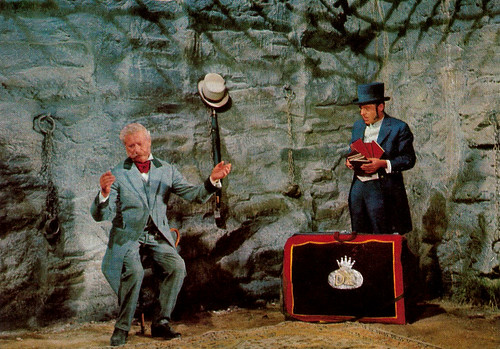
German postcard by Heinerle Karl-May-Postkarten, no. 44. Photo: CCC / Gloria. Dieter Borsche and Chris Howland in Der Schut/The Yellow One (Robert Siodmak, 1964). Caption: "The Lord and his servant won't be shaken by the situation. Archie has in his magical suitcase everything ready to make his Lord's stay in the cave as pleasant as possible."
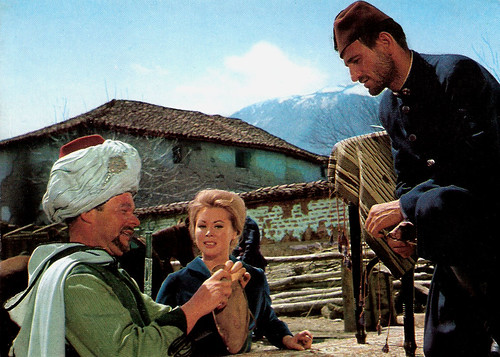
German postcard by Heinerle Karl-May-Postkarten, no. 46. Photo: CCC / Gloria. Ralf Wolter and Marianne Hold in Der Schut/The Yellow One (Robert Siodmak, 1964). Caption: "By a ruse and with the help of Turkish soldiers, the faithful servant Halef can free his beloved Lord, Kara Ben Nemsi, from the hands of the Yellow One, who has imprisoned him."

German postcard by Heinerle Karl-May-Postkarten, no. 48. Photo: CCC / Gloria. Ralf Wolter and Lex Barker in Der Schut/The Yellow One (Robert Siodmak, 1964). Caption: "The Farewell Bell Tolls. Kara wants to return to his homeland. Sad Halef says his beloved Lord "Good-bye". 'Sidi, we 'll meet again, when the son of Rih has seen the light of day!'"

German postcard by Filmbilder-Vertrieb Ernst Freihoff, Essen, no. 921. Retail price: 10 Pfg. Photo: Gloria / Schnelle. Marie Versini as Tschita in Der Schut/The Yellow One (Robert Siodmak, 1964).

German postcard by Rüdel-Verlag. Photo: CCC / Gloria. Rik Battaglia in Der Schut/The Yellow One (Robert Siodmak, 1964).
Sources: Wikipedia and IMDb.


